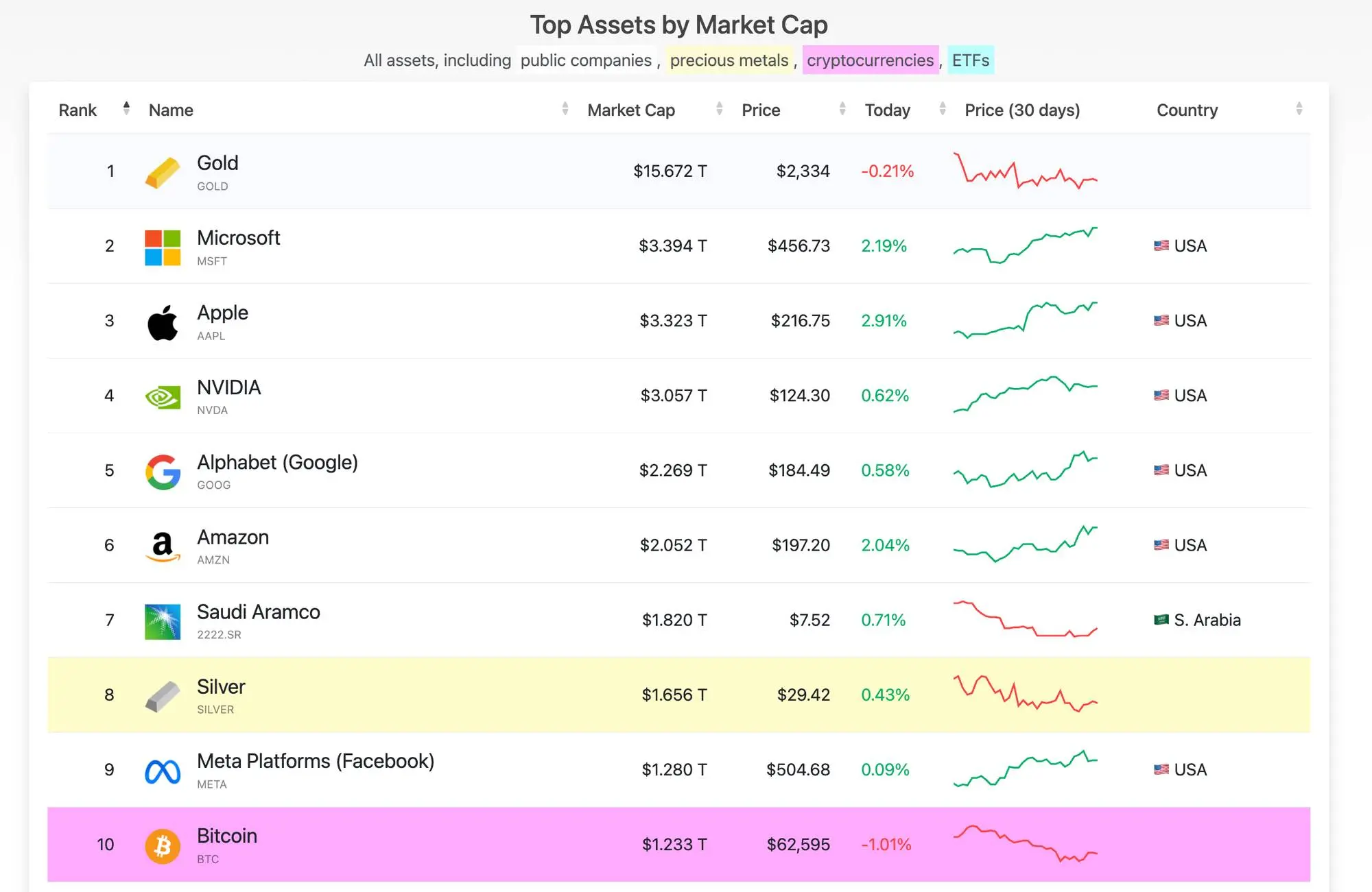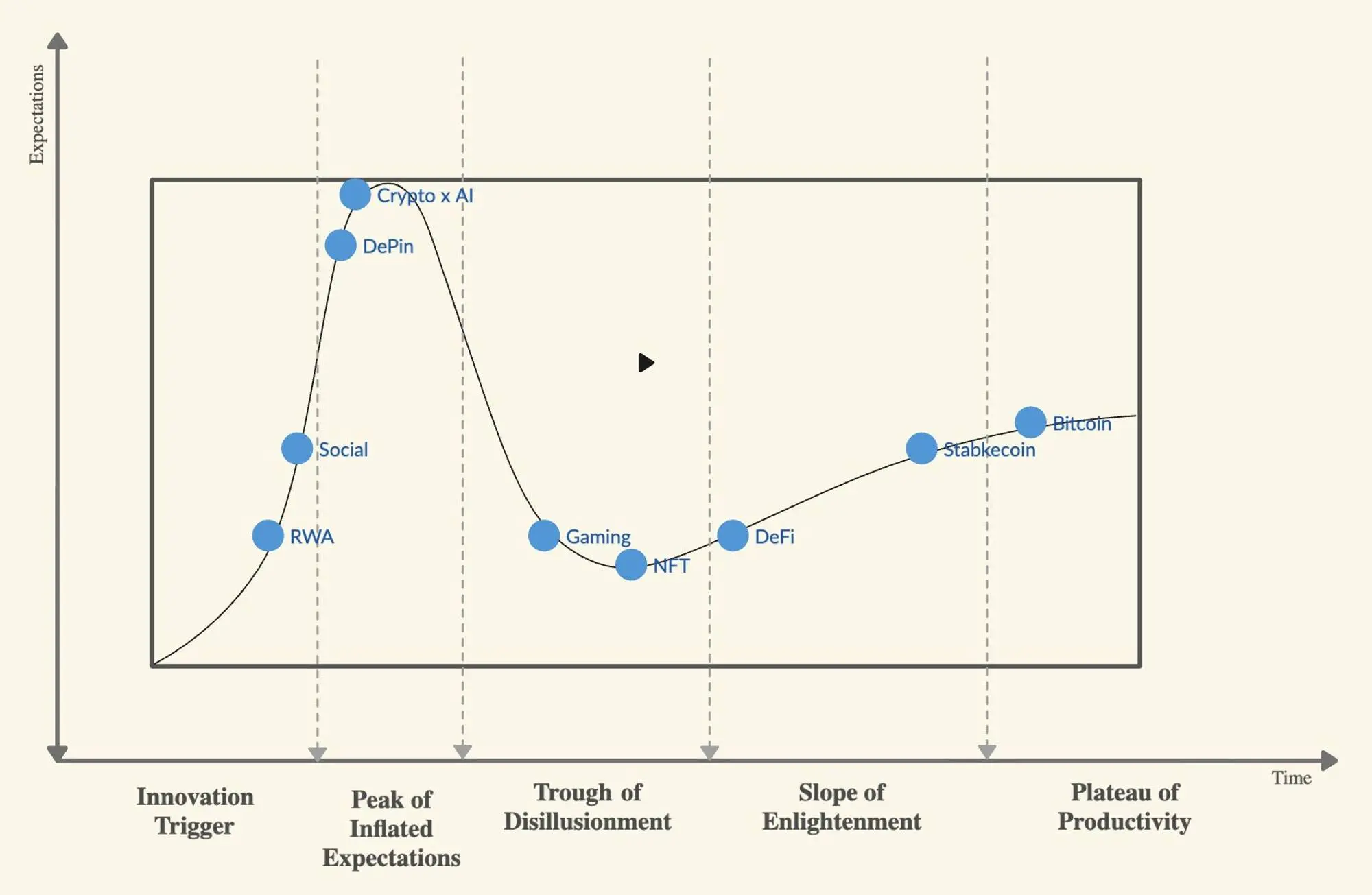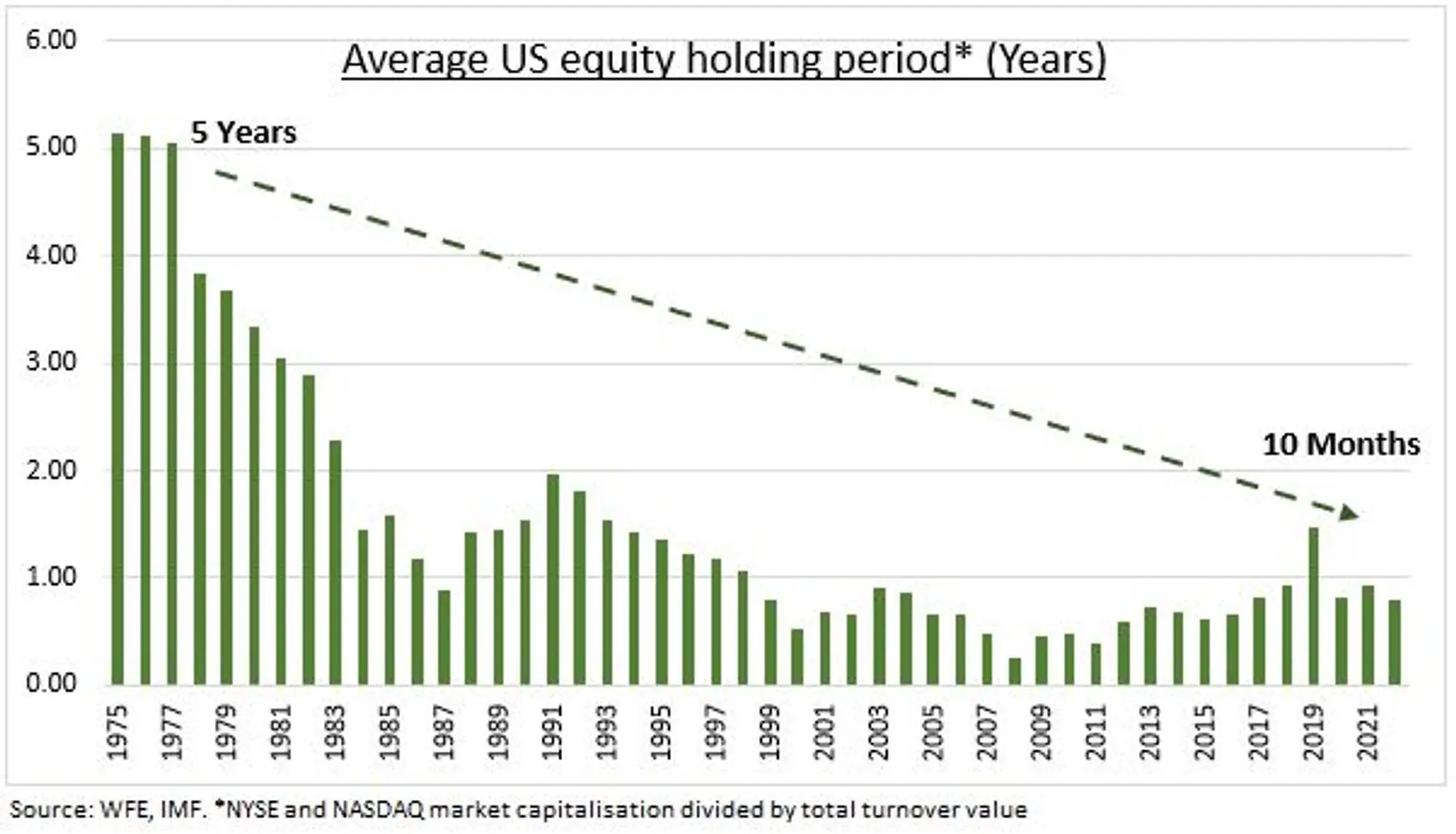The conclusion of the prologue and the opening of a new chapter: Reflection on the current state of the cryptocurrency industry and future aspirations
Author: pillarbear, Four Pillars
Compiled by: Yangz, Techub News
Article Summary
The narrative game rules driving the cryptocurrency industry are beginning to shift, and market participants are forming a meta-awareness of the narrative game itself.
The cryptocurrency industry urgently needs applications that can generate demand for block space.
The greatest advantage of cryptocurrency lies in its ability to assign economic value to any idea and provide a trading platform. Recently, new experimental forms utilizing attention economy and speculative characteristics have emerged in the market, such as memecoins, social trading, and prediction markets. There is potential for more diverse on-chain applications and business models in the future.
For on-chain applications, speculation is one of the most powerful features. The social demand for speculation is continuously increasing and can attract "degens."
In the long run, the industry's goal should be to provide value beyond speculation. It is necessary to convert users attracted by speculative demand into users who genuinely appreciate the core value of services, establish a sustainable token economy, and ultimately provide social graphs and product value that transcend speculation.

Source: Delievery at Dawn | a 4844 film
As Paradigm co-founder Matt Huang said, we are like building casinos on Mars. From redefining money to reshaping interactions with applications, the systems and mechanisms established by society are being reimagined to adapt to a new paradigm known as "Crypto." It transcends the realm of technological innovation, embodying different cultural and social meanings. For libertarians, cryptocurrency offers a pathway to free markets and self-governance. For crypto punks, it provides a censorship-resistant, permissionless value exchange network. For entrepreneurs, cryptocurrency is the foundation for building the next generation of the internet. For traders, it is a source of endless dopamine and potential profits. Depending on individual perspectives, the casino built by cryptocurrency will vary greatly. What do you think about the future shaped by cryptocurrency?

2024 is already halfway through, and looking back, this year has been vibrant, highlighting the multifaceted nature of the cryptocurrency industry. Bitcoin gained institutional recognition through ETFs. Ethereum successfully implemented the Dencun upgrade, including EIP-4844. Rollups have been deployed across numerous projects and have become the mainstream solution for launching new chains. Solana has experienced an astonishing revival after a difficult period, and the bull market that began last year has sparked investor enthusiasm for memecoins and celebrity coins.
In terms of applications, we have seen significant developments in the cryptocurrency space. Over time, mainstream DeFi protocols have matured and steadily grown. Meanwhile, tracks like SocialFi and narratives such as re-staking and artificial intelligence have attracted attention and speculation.
Compared to the previous bear market, the market has clearly rebounded. However, alongside the recovery, unprecedented polarization has emerged within the industry. Regarding memecoins, on one hand, opponents claim they are meaningless speculative behavior, while supporters argue they represent innovation "going to market," exemplifying a new model of attention economy. Additionally, in terms of narrative, the industry has split into two factions: one praises the evolution of new narratives and infrastructure, while the other grows weary of elitism in the field.
Since the birth of Bitcoin in 2008, the cryptocurrency industry has traversed a more tumultuous path than any other industry, experiencing multiple cycles of growth and decline to arrive at its current state. When public interest shows signs of waning, the industry dramatically resurfaces, triggering new narratives and hype. Similarly, the future development of the cryptocurrency industry encompasses countless scenarios and possibilities. This article reflects on the narrative games that have driven the cryptocurrency industry thus far, explores the latest trends in the ever-changing industry landscape, and contemplates the direction of the industry's development.
Narrative Games

Source: Fractal Lives
It all started with Bitcoin. Since its inception, the cryptocurrency industry has undergone countless developments and changes, yet Bitcoin remains the benchmark for the entire industry. As of the time of writing, Bitcoin's market capitalization has reached $1.2 trillion, ranking tenth among all asset classes. With the approval of spot ETFs, Bitcoin has further solidified its status as "digital gold." The reason Bitcoin can achieve a market capitalization of $1.2 trillion is not because it is a business based on operating profits, but because it is viewed as a scarce and legitimate asset. Even the world's most widely used payment networks, Visa and Mastercard, have market capitalizations that are less than half of Bitcoin's.

Source: Visions of Bitcoin
Bitcoin was not initially regarded as "digital gold." In the early days, most people considered Bitcoin a new form of electronic currency or a low-cost payment network. In the early 2010s, it was widely viewed as a dark web currency. However, over time, Bitcoin gradually gained legitimacy, and its narrative shifted from a medium of exchange to a store of value. The latter part of the chart, around 2018, clearly indicates that public opinion leaned more towards viewing Bitcoin as an asset class rather than a payment network. Although the chart does not display data beyond 2018, the rhetoric surrounding Bitcoin as "digital gold" has not only persisted but has also strengthened.
Satoshi Nakamoto's insight into Bitcoin is that the essence of money arises from social consensus. The blockchain is merely a cryptographic realization of social consensus among participants. The value of such a network depends on participants' evaluations of it. If Bitcoin were merely viewed as a payment network or dark web currency, rather than a narrative of value storage, achieving its current value would be exceedingly difficult.
Bitcoin's success set the standard for subsequent protocols and tokens. Like Bitcoin, most tokens in the cryptocurrency space possess both commercial and asset characteristics. Additionally, the blockchain's censorship resistance and permissionless nature provide a foundation for anyone to issue tokens and allow others to trade them. To enhance the value of a token, each protocol needs to gain the recognition of more people regarding its vision and convince them that its token holds value.

Source: X(@alphanonceStaff)
Thus, a unique culture of "narrative games" began to flourish throughout the cryptocurrency industry. Emerging industries often prioritize future potential over the immediate tangible benefits for users. However, in the cryptocurrency space, this narrative-driven approach has become dominant. Since the rise of the ICO craze, marketing strategies based on compelling stories have proven effective, as people rushed to publish white papers, a trend that continues to this day. The most influential figures in the cryptocurrency space have always been philosophers, researchers, and thought leaders. The tendency to idolize these figures has become one of the most notable characteristics of the industry.
Moreover, narrative games are particularly effective because most participants in the cryptocurrency market are investors and traders. The success of crypto narrative games relies not only on effective marketing campaigns. Its greatest advantage lies in its permissionless nature and ownership model, allowing anyone to tokenize any idea and assign it economic value. The more compelling and attractive the narrative a project can present, the more it will be directly linked to its market value. As token prices rise and trading volumes increase, traders will continuously seek the next captivating story, while project teams create an endless loop to provide these narratives. The cryptocurrency industry maintains its growth in a cycle of new narratives constantly emerging and fading.

Source: X(@intuitio_)
The memecoin craze that began earlier this year has exposed the essence of the narrative game in the cryptocurrency industry. The phenomenon of these tokens, which offer almost no real utility or vision, being sought after in the market clearly demonstrates that narrative games remain the dominant force driving the cryptocurrency market.
The rise of memecoins is not solely due to speculation. It also reflects a critique of the elitism in the pursuit of complexity within cryptocurrency and the market imbalance between retail and VC. As the industry matures, truly innovative narratives are becoming increasingly scarce. More and more projects are branding themselves as the next "blockchain revolution" with only slight differences. This has led to platform saturation, excess block space, and fatigue over repetitive narratives. Furthermore, mainstream projects can even secure exaggerated valuations from VCs before their launch and attempt to control prices through limited circulating supplies. This situation makes it difficult for many retail investors to participate in the narrative game.

Source: X(@gainzy222)
The significance of cryptocurrency narratives and the way practitioners consume these narratives are changing. It remains unclear how long the old routine of creating new stories to justify high market valuations can continue. However, we cannot expect new technological innovations or business models to emerge weekly.
Historically, the cryptocurrency industry has largely based its narratives on technological breakthroughs and capital efficiency. Now, investors and users seem to have developed a meta-awareness of the narrative game itself. The narrative game of cryptocurrency appears to be evolving in a polarized manner. One side complains that new innovations and narratives are not as good as before, while the other side continuously hypes newly emerging memecoins and popular projects, only to watch them burst like bubbles. In the near future, we may see this change become more pronounced.
Where Are We Now?
Since its inception, the narrative game of cryptocurrency has undoubtedly played a crucial role in building the industry's foundation. Not only does the cryptocurrency industry need to maintain token prices, but it also requires goals and visions to prove its existence and potential, especially under the pressures of fraud, speculation, and regulation. Many have embraced the vision of blockchain and Web3, dedicating themselves to advancing the industry and playing a significant role in shaping its current form.
However, the technical limitations of blockchain and Web3 are quite evident. For everyday applications, networks with sufficient security and censorship resistance are too slow and costly. During the DeFi and NFT Summer, transaction fees on Ethereum often exceeded $100.

Source: Rollup.wtf
Fortunately, thanks to the efforts of engineers and researchers, blockchain technology has steadily advanced. Now, secure and scalable blockchain spaces have become a reality. Most L2 or high-performance chains have transaction fees below $0.01 and speeds comparable to traditional applications.

Source: The Myth of The Infrastructure Phase
Looking back, Bitcoin has been around for 16 years, and Ethereum for 9 years. Over these years, the cryptocurrency industry has experienced several cycles of infrastructure and application development, marked by both technological advancements and declines driven by greed. In the initial stages, the industry's development was relatively slow due to a lack of demand and resources needed for research and development. By 2020, during the DeFi and NFT Summer, demand for applications began to explode, but the systems supporting this demand were insufficient. At that time, we felt a deep need for stable and scalable infrastructure.
The crypto winter after 2022 marked a rapid development period for blockchain infrastructure. Rollups, data availability layers, and ZK technology transitioned from research phases to commercialization. The market actively adopted these innovative technologies. Integrated chains like Solana attracted new users with their low-cost and fast transactions. High-performance chains like Sui and Monad have also garnered interest and are expected to launch more applications in the foreseeable future.
The development of infrastructure and applications is complementary; neither is more important than the other, nor does one need to prioritize over the other. Applications stimulate demand for infrastructure. Conversely, advanced infrastructure lays the groundwork for new applications. YouTube was able to emerge in 2005 rather than 1995 because of the widespread adoption of broadband infrastructure. The proliferation of broadband was facilitated by the success of early internet companies like Amazon and eBay.

Source: X(@Imrankhan)
There is still significant room for improvement in blockchain technology. We look forward to seeing networks that provide better user experiences and security gain wider adoption. However, it is undeniable that the narrative in the cryptocurrency industry has been overly focused on technological improvements and ideological concepts. Now, it is time for applications in the crypto industry to stimulate the development of infrastructure. Most importantly, we need applications that can generate demand for block space.
As mentioned earlier, there has always been a market demand for new narratives in the cryptocurrency industry, a tendency that is particularly strong in the Web3 environment where value accumulation is concentrated at the protocol layer. Therefore, almost out of inertia, the industry continues to show a preference for platforms and infrastructure, while the emergence of applications lags behind, and their impact on users is underestimated.

Source: Vitalik Buterin (EthCC 2022)
After the Ethereum Dencun upgrade earlier this year, Vitalik Buterin shared his views on the future direction of the cryptocurrency industry.
Today, I want to say that we are clearly on the right side of this S-curve, which is the deceleration period. As of two weeks ago, the two biggest changes for Ethereum, namely switching to proof of stake and restructuring blobs, have become history. Further improvements are still important, but they will not have as dramatic an impact as proof of stake and sharding.
The first decade of Ethereum largely belonged to the "intern" stage, aimed at making Ethereum L1 a reality, with applications primarily used by a small group of enthusiasts. Until a few years ago, we were still setting a low standard for ourselves, building applications that were clearly not scalable, as long as they could run as prototypes and be reasonably decentralized.
Now, we have most of the tools needed to build user-friendly applications with a crypto punk style. We should let go and do it; developers have no excuses left.

Source: X(@QwQiao)
If we break it down by track, tokens as stores of value (like Bitcoin) and stablecoins as payment methods have entered a mature stage. Stablecoins have become on-chain reserve currencies and are actively adopted in countries with unstable currencies, such as those in Latin America or Africa. The DeFi space has also moved beyond the disillusionment phase, and the businesses of mainstream projects are stabilizing. Token Terminal data shows that MakerDAO generated $3 million in revenue in Q1 2024, annualizing to about $12 million. However, the market cap of this token is only $20 billion, with a price-to-earnings ratio of about 16. Even compared to traditional fintech companies, this does not seem overvalued.
On the other hand, applications for a broader user base are still limited in some areas. NFTs seem to be experiencing a "disillusionment." After the bull market of 2021, most NFT projects, except for a few core IPs, failed to gain social favor. Moreover, even though the market has high hopes for gaming, the performance in this track is not optimistic and has been largely ignored by users. As for other tracks like artificial intelligence, DePIN, and social, they have either not yet reached the peak of hype or are just at the beginning of innovation.

The cryptocurrency industry has crossed a critical threshold. Despite facing various challenges, including the Terra and Luna incidents, the collapse of FTX, a harsh macro environment, and regulatory pressures, cryptocurrency continues to move forward. Even in extreme hypothetical scenarios, imagining the entire industry collapsing has become highly unreasonable. However, it is undeniable that the applications of blockchain are still primarily confined to finance and trading, catering to a limited user base and lacking mainstream appeal.
The current cryptocurrency industry stands at a crossroads, potentially continuing to maintain its current state with only incremental improvements in mature areas like tokens as stores of value or DeFi. This does not mean that continuing to play the role of a currency market is meaningless; it simply suggests that if this continues, the cryptocurrency industry will only be a market driven by enthusiasts, much like the poker or cannabis industry. Cryptocurrency has enormous potential as an application layer. Ideally, after leveraging this, we could fully embrace mainstream application adoption and the emergence of new business models.
Tokenizing Everything

Source: Insights from 'The Almanack of Naval Ravikant'
Traditionally, only individuals or businesses with capital and labor had leverage. However, the proliferation of software and media has broken this situation. Software enables anyone with minimal capital to develop applications and services, leading to innovation and the birth of numerous platforms and SaaS products. The widespread use of platforms like YouTube and Instagram can amplify individual influence, triggering a "Cambrian explosion" of influencers and small media.
The greatest value offered by cryptocurrency lies in its ability to assign economic value to any idea and provide a trading platform. In traditional systems, the formation of markets requires the intervention and permission of intermediaries to maintain economic value and mutual trust. However, blockchain technology provides the foundation for tokenization, allowing users to exchange economic value with others over the internet without needing to trust or obtain permission from others.

The term "meme" was first introduced by Richard Dawkins in his book "The Selfish Gene" as a concept similar to genes, where genes physically transmit hereditary information. In society, a meme is a cultural unit that can represent a certain idea, trend, or fashion. Later, memes adapted to internet culture and have been widely used in their current meaning. Memes spread through social interaction, evolving through replication, modification, and reproduction, much like genes.
Recently, Michael Rinko from Delphi Digital emphasized in his article "Attention is all you need" that cryptocurrency assigns economic value to people's ideas and interests, allowing users to own their interests and profit from them.
On Instagram, we follow brands and influencers. But the most I can do is repost and share this content with friends. Our attention is 100% captured by others.
Cryptocurrency is different; it democratizes attention, allowing us to own it. If you find yourself spending a lot of time on certain topics, you can truly own your attention and profit from it. This idea is obvious and seems silly, but it represents a significant shift in internet economics.
Memecoins have taken the framework of "attention equals value" to the extreme. They provide the purest way to buy tokens because you believe they will attract attention in the future.

Source: X(@jessewldn)
One thing that must be recognized is that memecoins themselves are not the most important. They are ultimately just a meme, and once they become uninteresting, they will quickly disappear from people's sight. What memecoins demonstrate is the raw potential of tokenization, hinting at the possibility of new applications emerging. From identity and data to the creator economy, the ability to assign economic value to attention paves the way for unprecedented markets and applications.
This has been particularly evident in the first half of 2024. The cryptocurrency market has revived, and applications that convert people's attention into speculative demand have rapidly gained traction.
Solana's pump.fun has become the primary platform for launching memecoins, with fees peaking among all protocols.
Friend.tech and Fantasy.top integrated social trading features associated with Twitter, generating strong speculative demand, achieving $65 million in fees and over $36 million in trading volume, respectively.
Farcaster-based Scenecoin DEGEN attracted a large number of users and activity through innovative airdrops and community incentives, contributing to the success of the Farcaster ecosystem.
During the U.S. presidential election, Polymarket saw a significant increase in activity and trading volume, recording $100 million in transactions in just June.
The Hamster Kombat of the TON ecosystem leveraged its simple functionality and seamless integration with Telegram to achieve a user base of 100 million.
While this list is not exhaustive, the release and experimentation of applications, both large and small, continue. Although the industry has existed for over a decade, the work of developing applications that leverage the unique characteristics of cryptocurrency has only just begun. The range of unique user experiences that on-chain applications can provide remains to be determined. We should pay more attention to these initiatives, as they offer meaningful experimental results on how cryptocurrency applications can meet user needs and adapt to the market. We look forward to more experiments in the still underexplored areas of cryptocurrency social, gaming, NFTs, and prediction markets.
Speculation is a Feature, Not a Flaw
Blockchain is a backend technology. Aside from chains designed for specific applications, most networks provide a general execution environment and database for applications to run. In principle, most applications we use daily could run on a blockchain. Just as software no longer markets its ability to run on mobile devices or use the cloud as a marketing keyword, cryptographic technology should not be used to describe application functionalities. Ultimately, "blockchain" or "cryptocurrency" will no longer be used to describe applications; users should be able to use applications without knowing the underlying chain or wallet.
When someone wants to launch a product or service, no one asks why it should be released online. Because deployment costs are lower, speeds are faster, and customers can enjoy greater convenience and accessibility than offline, except in special cases. Similarly, it is foreseeable that running applications on-chain will eventually be seen as a natural thing. As permissionless markets and interconnected application ecosystem wallets become commonplace, we will no longer question why applications need to run on a blockchain.
However, in the currently limited blockchain environment, such assumptions are merely hopeful. The current blockchain development environment remains challenging; users are not only unfamiliar with wallets but also tend to avoid them. Aside from a small group of enthusiasts, most users require strong motivation to use on-chain applications. This is not just about improving adoption rates by 10% or 20%; what we need are user experiences and functionalities that can only be realized in an on-chain environment.

Source: Sound.xyz
Most users in the industry are "airdrop hunters" and traders, whose primary goal is to satisfy speculative demand. Those pursuing the ideals of cryptocurrency believe this speculation contradicts the fundamental purpose of cryptocurrency and try to distance themselves from such practices. However, we need to reassess the role these "degens" play in the industry. It is no exaggeration to say that the cryptocurrency industry is built on the foundation of injecting capital through speculation. The fact that most on-chain trading volumes are based on speculative demand, arbitrage, or MEV profits cannot be ignored. Infrastructure without users is worthless, and there is no doubt that degens are a crucial pillar of the cryptocurrency industry.
During the 2021 NFT Summer, many companies and brands joked about entering the cryptocurrency industry, and everyone was excited about it. However, the ones that ultimately succeeded were not Disney, but Pudgy Penguins. Cryptocurrency has reached a level where it can sustain growth independently. Compared to external entities entering the cryptocurrency industry, the outward expansion of successful products within the industry may be a more likely path to achieving mainstream adoption. Ultimately, degens are the early adopters and core user base of all on-chain applications, and meeting their needs should be the first step in validating product-market fit.

Source: eToro
The preference for speculation is not limited to cryptocurrency; it is a social phenomenon. The deepening economic inequality and the shortening attention spans influenced by social media have led people to continuously increase their risk tolerance for investment assets. In the 1970s, the average holding period for Americans was 5 years, while by 2020, this number had dropped to 10 months.
It would be unfair to blame Generation Z's high-risk preference for their lack of focus or gambling tendencies. In most major countries today, it has become increasingly difficult for the younger generation to live better lives than their parents. Recognizing that labor income cannot exceed capital income, many investors adopt a "nothing to lose" mentality when investing. They may not have much to wager, but if they do not actively place bets, their chances of surviving at the table will diminish.
While the current situation is undoubtedly dystopian, the high volatility of tokens is seen by many as an opportunity to turn their fortunes around. It has been proven that easily accessible speculative assets like memecoins are a primary means of attracting new users into the cryptocurrency industry. Driven by the memecoin craze in the Solana ecosystem, Phantom Wallet ranked third in the utility category on the U.S. App Store, with monthly users reaching 7 million. Users attracted by speculative demand, while using the applications, inadvertently learn about digital ownership, wallets, and markets, thereby integrating into the culture and potentially converting into organic traffic.

Source: X(@0xJim)
Although most on-chain applications have attracted significant attention in the short term by leveraging unique user experiences and speculative demand, their lifecycles are often short due to rough designs and strong speculation. However, from this perspective, concluding that on-chain applications cannot achieve structural retention is overly hasty.
The short lifecycles of on-chain applications can be attributed to several reasons: the majority of the user base consists of degens and traders, who exhibit very low loyalty to products; the time and resources allocated to product development are minimal compared to infrastructure development; and most products overly focus on short-term speculation rather than long-term utility.
Finally, I want to say that if speculation is the only use of cryptocurrency, then I would not contribute to this industry. However, to realize the Web3 vision of cryptocurrency and make general applications like gaming and social platforms accessible, we must consider not only the goals but also the feasible paths to achieve those goals. Given the current industry and social environment, speculative demand seems to be the most powerful tool that cryptocurrency can leverage.
However, in the long run, it is essential to convert users attracted by speculative demand into users who genuinely appreciate the core value of services, thereby establishing a meaningful funnel that promotes interactions beyond speculation. Additionally, a token issuance and distribution framework must be developed that can withstand short-term fluctuations in price and demand, ultimately providing social graphs and product value that transcend speculation.
The End of the Prologue

Source: "Bitcoin Is Dead"
People's emotional fluctuations are even more intense than the fluctuations in token prices. When prices drop, everyone pronounces the market dead. Bitcoin has been passively "dying" every year since its inception. I believe the cryptocurrency industry has developed to a level where it can operate and grow without external intervention. However, the next two to three years will be a critical period to determine whether the industry can realize the Web3 vision and become mainstream. If important products cannot validate their market fit during this cycle, then there will be no excuses.

The first general-purpose blockchain, Ethereum, has been launched for 10 years. Despite extensive research and development over the years and the industry's ups and downs, it has only recently developed into a technology that can be reliably used by actual users. While token prices and narrative games have always driven the industry's development, now more than ever, we should focus on products and their impact on actual users.









